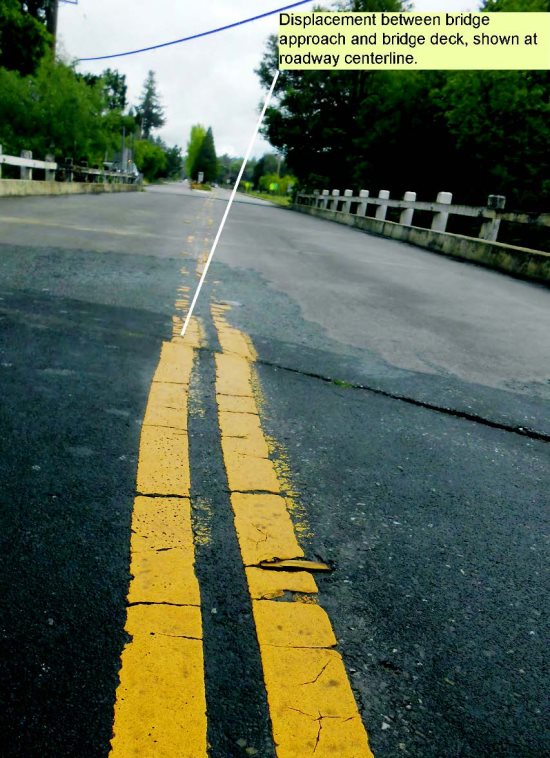| | Published June 28th, 2017
| Moraga decides to install a one-lane temporary bridge
| | | By Sophie Braccini |  | | Image provided |
After reviewing different options, the Moraga Town Council chose gave the go-ahead to install a temporary one-lane bridge into Canyon, alleviating the dramatic impact the closure of the bridge has had on that community.
 Because of the permits and preliminary work that has to be done, city staff's expectation is that it will be set in place by mid-September.
Because of the permits and preliminary work that has to be done, city staff's expectation is that it will be set in place by mid-September.
 The town of Moraga has been at the center of a controversy regarding its management of the bridge crisis, as some Canyon residents - the most impacted by the bridge closure - questioned the staff's decision-making. But during the June 14 council meeting, Edric Kwan, the town's public work director, detailed the situation and the critical path forward in a way that convinced the town council and most of the audience that the decision was sound.
The town of Moraga has been at the center of a controversy regarding its management of the bridge crisis, as some Canyon residents - the most impacted by the bridge closure - questioned the staff's decision-making. But during the June 14 council meeting, Edric Kwan, the town's public work director, detailed the situation and the critical path forward in a way that convinced the town council and most of the audience that the decision was sound.
 Kwan made clear that the issue was complex, including an unstable hillside that needs to be consolidated. Kwan explained that the town is working two parallel tracks, in coordination with the proper federal and state public agencies: One to provide an emergency solution and restore some traffic in the short term, and another is preparing for the longterm restoration and improvement of the bridge.
Kwan made clear that the issue was complex, including an unstable hillside that needs to be consolidated. Kwan explained that the town is working two parallel tracks, in coordination with the proper federal and state public agencies: One to provide an emergency solution and restore some traffic in the short term, and another is preparing for the longterm restoration and improvement of the bridge.
 The regulation that governs emergency relief and reimbursement is very restrictive about what is covered and what is not, so the town, which does not have a lot of financial reserves, needed to walk a narrow path in order to get 100 percent reimbursement, Kwan said.
The regulation that governs emergency relief and reimbursement is very restrictive about what is covered and what is not, so the town, which does not have a lot of financial reserves, needed to walk a narrow path in order to get 100 percent reimbursement, Kwan said.
 He presented six possible options, ranging from doing nothing until the permanent bridge is completed, to installing a one-lane or two-lane temporary bridge.
He presented six possible options, ranging from doing nothing until the permanent bridge is completed, to installing a one-lane or two-lane temporary bridge.
 The way the hill is handled creates alternate scenarios: complete repair is of course more expansive and takes longer; the alternative being to build an abutment to protect the southern side of the bridge. According to staff and its consultants, the cost varies from $2 million to $4.6 million, and the length of time from two-and-a-half years to four months. The shortest option is also the least expensive: construct an abutment to contain the hill and install a one-lane temporary bridge. Kwan explained that one lane is all that is permitted by the federal administration as an emergency solution. It is, according to the director, the only route the town can take to get 100 percent of the cost back.
The way the hill is handled creates alternate scenarios: complete repair is of course more expansive and takes longer; the alternative being to build an abutment to protect the southern side of the bridge. According to staff and its consultants, the cost varies from $2 million to $4.6 million, and the length of time from two-and-a-half years to four months. The shortest option is also the least expensive: construct an abutment to contain the hill and install a one-lane temporary bridge. Kwan explained that one lane is all that is permitted by the federal administration as an emergency solution. It is, according to the director, the only route the town can take to get 100 percent of the cost back.
 Several people in attendance expressed doubt regarding the town's strategy. Brian Coyle, vice-president of the Canyon school district board, insisted that while he did not mean to offend Moraga, he worried that they were not competent to determine something as complex as this situation. He said that the determination of the bridge's safety should be done by the California Department of Transportation and that paying consultants half a million dollars to assess the needs when they would also get repair work was a conflict of interest.
Several people in attendance expressed doubt regarding the town's strategy. Brian Coyle, vice-president of the Canyon school district board, insisted that while he did not mean to offend Moraga, he worried that they were not competent to determine something as complex as this situation. He said that the determination of the bridge's safety should be done by the California Department of Transportation and that paying consultants half a million dollars to assess the needs when they would also get repair work was a conflict of interest.
 Moraga staff had indicated that it was working in conjunction with Caltrans.
Moraga staff had indicated that it was working in conjunction with Caltrans.
 Moraga resident Steve Woehleke wondered if all alternatives had been studied, saying that there had not been a broader overview of how to provide safety to Canyon for the next two years. Michael Carradine asked why the town would not consider a culvert instead of a bridge, a much cheaper and faster solution he said. Kwan responded that this option had been looked at but could not be considered because the California Department of Fish and Wildlife would not allow it and the town would not be reimbursed.
Moraga resident Steve Woehleke wondered if all alternatives had been studied, saying that there had not been a broader overview of how to provide safety to Canyon for the next two years. Michael Carradine asked why the town would not consider a culvert instead of a bridge, a much cheaper and faster solution he said. Kwan responded that this option had been looked at but could not be considered because the California Department of Fish and Wildlife would not allow it and the town would not be reimbursed.
 Council member Dave Trotter asked Kwan what chance the town had to have Caltrans approve the adopted measures as part of the management of an emergency. The director confirmed that his team was working closely with the agency. Council member Kymberleigh Korpus said that she was impressed with the quality of the research and presentation but asked why the total cost was so high, when renting a bridge was about $400,000. The town's team explained that the cost of an abutment next to a creek was very expensive and that the cost estimate included contingency funds. Council member Janet Fritzky wondered if EBMUD, which owns the hill, should not be considering working to protect the future bridge; there was no answer to her remarks.
Council member Dave Trotter asked Kwan what chance the town had to have Caltrans approve the adopted measures as part of the management of an emergency. The director confirmed that his team was working closely with the agency. Council member Kymberleigh Korpus said that she was impressed with the quality of the research and presentation but asked why the total cost was so high, when renting a bridge was about $400,000. The town's team explained that the cost of an abutment next to a creek was very expensive and that the cost estimate included contingency funds. Council member Janet Fritzky wondered if EBMUD, which owns the hill, should not be considering working to protect the future bridge; there was no answer to her remarks.
 The first steps in mid-July are to obtain Caltrans and environmental clearances, as well as removing the utilities that are under the bridge. By the end of July the environmental mitigation measures should be completed, just before the old bridge is removed and the abutment constructed in August. Staff expects to open the one lane bridge that will be controlled by traffic lights by mid-September.
The first steps in mid-July are to obtain Caltrans and environmental clearances, as well as removing the utilities that are under the bridge. By the end of July the environmental mitigation measures should be completed, just before the old bridge is removed and the abutment constructed in August. Staff expects to open the one lane bridge that will be controlled by traffic lights by mid-September.

|
| | | | | | | | | | | | |



